Zinc and Vitamin D
It appears that
Low Zinc results in less vitamin D in blood getting to tissues
Colds can be stopped by taking Zinc every 2-3 hours
- COVID-19 risks appear to decrease by taking Zinc frequently
Zinc improves the immune system and influences 300 enzymes
Zinc deficiency has increased due to lack of Zinc in fertilizers as well as Roundup problems
20% of the people in the world do not get enough Zinc
Zinc taste tests kind-of, sort-of work
No agreement as to the best Zinc supplement
Zinc loading doses appear to be safe
Not much daily zinc is needed - 10 mg seems OK for most people,
- 20 mg has been proven to cut in half the progression of prediabetes to diabetes
- FYI: Zinc is the oldest knows pill - used by the Romans WikiPedia
Some hints that Zinc is important
- The base of the fingers of Vitamin D Receptors contain a zinc molecule
- Deficiencies of Vitamin D, Iron, Magnesium, and Zinc all associated with ADHD – Sept 2014
- Zinc is needed to use Omega-3
Adding Zinc to plants in India decreases decreases child stunting by 1 in 100 children
Hypothesis – Fatigue the day after sex is due to deficiency of vitamin D or Magnesium or Zinc
Grassrootshealth participant Zinc levels, etc - Dec 2023
What Are the Zinc Levels of GrassrootsHealth Participants?
Zinc is a key cofactor for approximately 3,000 proteins and enzymes in the body
2023 7.2 average
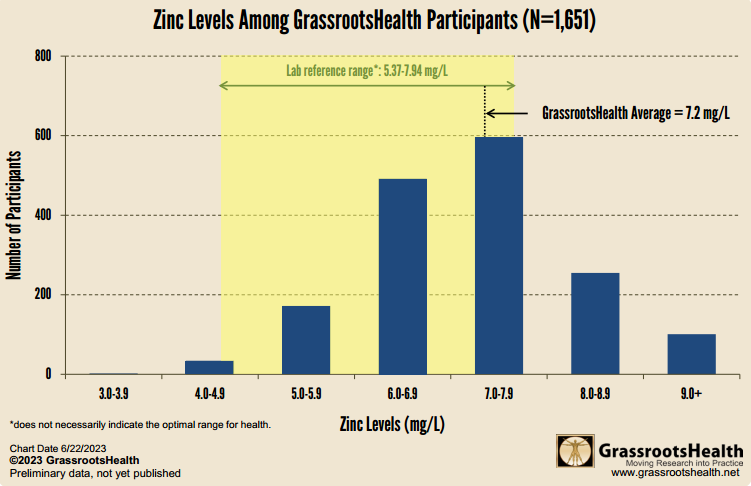
2020: 6.7 average
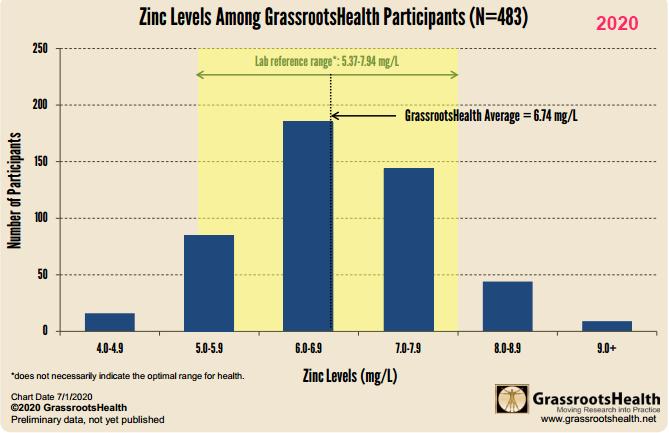
Zinc supplementation increased weight, height etc, of children - meta-analysis Oct 2023
The effect of zinc supplementation on anthropometric measurements in healthy children over two years: a systematic review and meta-analysis
Meta-Analysis BMC Pediatr . 2023 Aug 23;23(1):414. doi: 10.1186/s12887-023-04249-x.
Vahid Monfared 1, Adel Salehian 1, Zeinab Nikniaz 2, Soraiya Ebrahimpour-Koujan 3, Zeinab Faghfoori 4

Small amount of Zinc increased weight
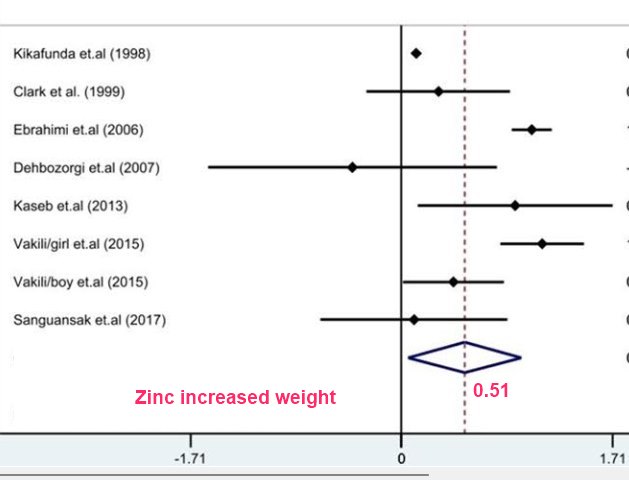
Background: Zinc deficiency is one of the most important micronutrient deficiencies in children that can affect the children's growth pattern. In this regard, different studies were conducted to assess the effect of zinc supplementation on growth patterns in healthy children. To the best of our knowledge, no systematic review has summarized the results of these studies. So, in the present study, we systematically reviewed the result of the studies that assessed the effect of zinc supplementation on anthropometric parameters in healthy, over 2-year-old children.
Methods: A systematic search was carried out in PubMed, Scopus, and Web of Science from inception to November 2021. Data were pooled using the random-effects method and were expressed as weighted mean difference (WMD) and 95% confidence intervals (CI).
Results: The pooled results of eight studies, including 1586 participants, showed that zinc supplementation significantly increases
height [(WMD): 0.9, 95% CI: (0.27, 1.52), p < 0.001],
weight [(WMD): 0.51, 95% CI: (0.06, 0.97), p < 0.001],
height for age (HAZ) [(WMD): 0.07, 95% CI: (0.03, 0.10), p < 0.001].
Also, meta-regression analysis did not reveal any significant association between dose and duration of intervention and anthropometric parameters.
Conclusion: The present study demonstrates the beneficial effects of zinc supplementation on weight, height, and HAZ.
📄 Download the PDF from Vitamin D Life
Liver problems in obese children decreased after 30 mg/day of Zinc for 4 months - RCT Nov 2023
Effects of Zinc Supplementation on Inflammatory Status and Nonalcoholic Steatohepatitis in Overweight or Obese Children: a Randomized Clinical Trial
Clinical Trial. Biol Trace Elem Res (2023). https://doi.org/10.1007/s12011-023-03954-z PDF behind paywall
Vahidreza Ostadmohammadi, Mohammad Javad Namazi, Mahsa Rezasoltani, Davood Kheirkhah, Mohammad Rajabi, Alireza Sharif, Abbas Taghavi Ardakani, Fariba Raygan, Amelia A. Assareh & Mohammad Reza Sharif
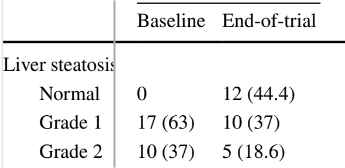
Study can be read on DeepDyve - if you get a trial subscription
The purpose of the present clinical trial was to determine the impact of zinc supplementation on serum liver enzymes, steatosis severity, lipid profile, and inflammatory status in overweight or obese children with nonalcoholic steatohepatitis (NASH). This randomized controlled trial was conducted by enrolling 60 children with NASH, aged 10–18 years old. The participants were randomly assigned to two groups that received either 30 mg/day of elemental zinc or placebo for 16 weeks. The severity of liver steatosis was evaluated using liver ultrasonography. Fasting blood samples were collected from each patient at the beginning and after 16 weeks of intervention to measure biochemical parameters. Following a 16-week intervention , zinc supplementation compared with placebo significantly decreased serum alanine aminotransferase (ALT) concentrations and high-sensitivity C-reactive protein and considerably enhanced HDL-cholesterol values. However, zinc intake had no considerable impact on aspartate aminotransferase, the severity of liver steatosis, anthropometric parameters, and other lipid indices versus the placebo group.
Overall, zinc supplementation showed a promising impact on serum ALT, HDL-cholesterol, and inflammatory status in overweight or obese children suffering from NASH. Zinc supplementation may be a new strategy for the amelioration of NASH in overweight or obese children.
This trial has been registered on the Iranian website for registration of clinical trials with the special ID of IRCT20200531047614N1
See also Zinc in Vitamin D Life
Vitamin and Mineral deficiencies – Ames Triage Theory Sept 2012
- U.S. population below EAR: magnesium 56%; zinc 12%
Zinc helps pregnancies – 14 percent fewer preterm births, etc. – Cochrane RCT Feb 2015
Headache has the following on Zinc
- __||Metal| Migraine|No Migraine| Ratio
- Zinc|0.24 ug| 5.77 ug| 24X LESS if increase ||__
Zinc in Vitamin D Life: studies
{category}
Meta-analysis found DAILY Zinc does not reduce colds much (not a news item)- Nov 2021
Zinc for the prevention or treatment of acute viral respiratory tract infections in adults: a rapid systematic review and meta-analysis of randomized controlled trials - BMJ Nov 2021📄 PDF
It was proven decades ago that for best results Zinc must be taken every 2 hours, not daily
Zinc fights Prostate Cancer - Dec 2022
**Zinc in Prostate Health and Disease: A Mini Review
Biomedicines 2022, 10(12), 3206; https://doi.org/10.3390/biomedicines10123206
by Nishi Karunasinghe
Auckland Cancer Society Research Centre, Faculty of Medical and Health Sciences, U. of Auckland, Private Bag 92019, Auckland 1142, New Zealand
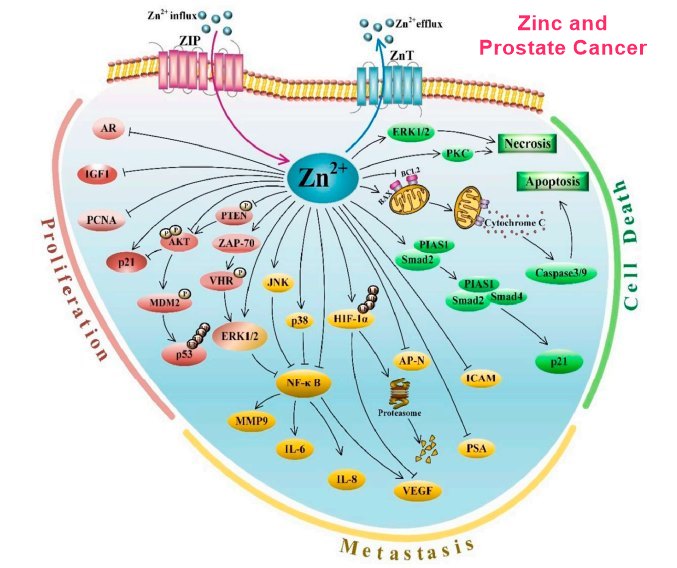
Introduction-With the high global prevalence of prostate cancer and associated mortalities, it is important to enhance current clinical practices for better prostate cancer outcomes. The current review is towards understanding the value of Zn towards this mission. Method-General information on Zn in biology and multiple aspects of Zn involvement in prostate health and disease were referred to in PubMed.
Results-The most influential feature of Zn towards prostate health is its ability to retain sufficient citrate levels for a healthy prostate. Zn deficiencies were recorded in serum, hair, and prostate tissue of men with prostate cancer compared to non-cancer controls. Zn gut absorption, albumin binding, and storage compete with various factors. There are multiple associations of Zn cellular influx and efflux transporters, Zn finger proteins, matrix metalloproteinases, and Zn signaling with prostate cancer outcomes. Such Zn marker variations associated with prostate cancer recorded from biological matrices may improve algorithms for prostate cancer screening, prognosis, and management when coupled with standard clinical practices.
Discussion-The influence of Zn in prostatic health and disease is multidimensional, therefore more personalized Zn requirements may be beneficial. Several opportunities exist to utilize and improve understanding of Zn associations with prostate health and disease.
{FONT(size="16")}* 📄 Download the PDF from Vitamin D Life *{FONT}
Dr. Rhonda Patrick on Zinc - July 2020* https://www.foundmyfitness.com/topics/zinc *1 Background
2 Dietary sources
3 Recommended dietary allowances for zinc
4 Zinc deficiency
4.1Populations at risk for zinc deficiency
5 Measurement of zinc status
6 Zinc transport and absorption
7 Zinc homeostasis and bioavailability
7.1Zinc and nutrient interactions
8 Zinc and DNA damage
9 Zinc and immune function
10 Zinc and age-related immune dysregulation
11 Zinc and pneumonia
12 Zinc and the common cold
13 Zinc and sepsis
13.1Zinc and nutritional immunity
13.2Zinc supplementation for the treatment of sepsis
14 Zinc and HIV
15 Zinc and the treatment of acne
16 Zinc and its role in childhood development, disease, and death
17 Zinc and the brain
17.1Zinc and Alzheimer’s disease
17.2Zinc and brain injury
17.3Zinc and depression
18 Zinc and age-related macular degeneration
19 Zinc and metabolic regulation
19.1Zinc and diabetes mellitus
19.2Zinc and lipoprotein metabolism
20 Zinc safety
20.1Zinc supplementation and copper deficiency
20.2Zinc supplementation and drug interactions
21 Zinc supplementation* 213 references *---
Zinc levels associated with vitamin D levels in children - Aug 2022* Serum Vitamin D, Zinc Levels and the Relationship between them in Children and Adolescents *Gülsen Şener, Zeynep Adıyaman Koçer, Tülin Bayrak, Ahmet Bayrak, Alper Gümüş - 10.7754/Clin.Lab.2021.211003 PDF is behind a paywall
" A positive significant correlation was found between serum 25(OH)D and Zn levels (r = 0.468; p < 0.001). "
41 Health Benefits of Zinc - July 2020* Selfhacked *2) Diarrhea; 3) Wilson’s disease; 4) Acrodermatitis Enteropathica; 5) Heart Disease; 6) Insulin Resistance and Diabetes; 7) Skin Health: Acne, Warts, Skin Damage; 8) Depression; 9) Appetite and Anorexia Nervosa; 10) Immunity & Infections; 11) Common Cold; 12) ADHD; 13) Eyesight; 14) Cognition; 15) Allergy and Asthma; 16) Wound Healing; 17) Bone Health; 18) Hair Loss; 19) Kidney Disease, Hemodialysis; 20) Pregnancy Outcomes; 21) Stunted Growth; 22) Women’s Health; 23) Liver Protection; 24) Hearing Disorders; 25) Oral Health; 26) Body Odor
See also web
- Zinc Top Ten Home Remedies 2017

2019 Overview of Zinc by Stat Pearls - need about 3 mg of Zinc for health, can take loading dose, avoid getting too much in long term
{ANAME()}Ztaste{ANAME}
- Lots of information, such as "zinc deficiency has been estimated to cause more than 450,000 deaths in children under the age of 5 annually"
Quackery or Solid Science: The Zinc Tally Test - Does it Work? How Does It Work? And How Reliable is It? Suppversity Jan 2014
- Many reviews conclude the Zinc taste test does not work (but low Zinc does make for poorer taste)
https://examine.com/supplements/zinc/ excellent with lots of links to clinical research
- "* Superloading zinc *by taking up to 100mg zinc a day is confirmed to be safe in the short term (2-4 months), but because this dose is higher than the 40mg Tolerable Upper Limit (TUL) of zinc, prolonged superloading is not advised. Zinc’s intestinal uptake is hindered by other minerals, including Calcium, Magnesium, and Iron, since they all use the same transporter. If the transporter’s uptake limit (800mg) is exceeding between these four minerals, absorption rates will fall. Taking less than 800mg of these four minerals at the same time is fine."
ConsumerLabs on Zinc updated Feb 2021
No consistent differences in bio-availability of the different Zinc compounds
They have excellent supplementation information on virtually all supplements $42/year -* but they have a 5 day free trial Behavioral impairments in animal models for zinc deficiency **- Jan 2015
{FONT(size="16")}* 📄 Download the PDF from Vitamin D Life *{FONT}
- has the following pentagon
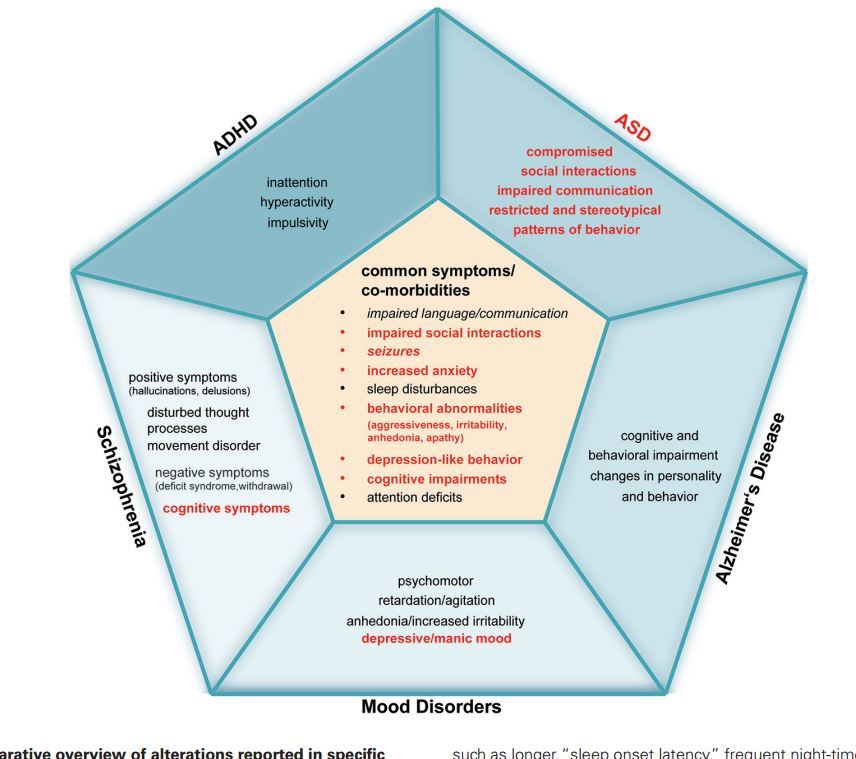
* 📄 Download the Jan 2015 PDF from Vitamin D Life * GLYPHOSATE IT BINDS MINERALS AND CUTS OFF THE PRODUCTION OF NEUROTRANSMITTERS AND HORMONES....A VISUAL CONNECTION OF THE ROUTES OF DISEASES AND CANCER * BINDS, CHELATES, ZINC, MANGANESE, SELENIUM, CHROMIUM, COBALT

* Estimating the Global Prevalence of Zinc Deficiency **PLOS ONE Nov 2012
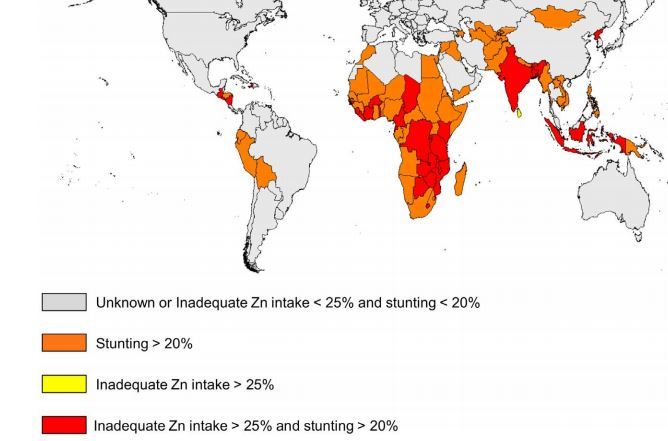
* 📄 Download the PDF from Vitamin D Life * Zinc Deficiency chapter WHO, date unknown
* 📄 Download the PDF from Vitamin D Life * Zinc Deficiency Wikipedia
"Central Anatolia, in Turkey, was a region with zinc-deficient soils and widespread zinc deficiency in humans. In 1993, a research project found that* yields could be increased by 6 to 8-fold *and child nutrition dramatically increased through zinc fertilization."
* http://www.zinc.org/crops/ * "A study for the Food and Agricultural Organization (FAO) by Sillanpää found that zinc was the most commonly deficient micronutrient in the world. The study, which examined 190 field trials in fifteen countries, found that zinc deficiency occurred in one out of every two trials."
 * Note: Taking Zinc acetate every 2 hours with vitamin C stops most colds *---
* Note: Taking Zinc acetate every 2 hours with vitamin C stops most colds *---
Mercola on Zinc
Zinc Is Crucial for Heart Health* Mercola *Jan 2016
"Zinc May Help Regulate Your Heartbeat"
"Your Body Contains More Than 300 Zinc-Dependent Enzymes"
"How Much Zinc Do You Need?" RDA is 11 mg/day (men) 8 mg/day (women)
Deficient due to* lack of Zinc in fertilizers, glyphosate which binds to Zinc ** ACE inhibitors and thiazide diuretics consume Zinc
Zinc decreases the potency of some antibiotics if taken concurrently
- No problem with potency if take antibiotics 2 hour before or 4 hours after the Zinc
Zinc* Mercola Feb 2018 -"While zinc and selenium deficiencies can occur at any age, by the time you reach 60, your risk can soar as high as 40 percent *."
signs of zinc deficiency:If food doesn't taste or smell as good as it used to, Brain fog and decreased alertness. Frequent respiratory illnesses. Difficulty sleeping. Slow wound healing, Lack of appetite, Leaky gut and gastrointestinal complaints, Occasional moodiness and feeling blue. Impaired hearing, Reduced libido, Occasional loose stools, Increased food and environmental allergies, Hair loss, rashes and other skin issues
"The fact that these signs mimic other conditions is one of the reasons many people never suspect a zinc deficiency. None of these stand out as a “zinc” red flag all by itself!"
"Second after iron, zinc is the most common mineral found in your body"
"Also, if you’re dealing with any type of chronic illness, ask your health practitioner about zinc."
"Emotional stress is one of the biggest factors behind zinc deficiency."
Zinc Is Key for COVID-19 Treatment and Prevention Mercola Oct 23, 2020
"Having a plasma zinc level lower than 50 mcg/dl at admission was associated with a* 2.3 times increased risk of in-hospital death *..."
"Amongst the COVID-19 patients, 27 (57.4%) were found to be zinc deficient. These patients were found to have higher rates of complications, acute respiratory distress syndrome (18.5% vs 0%), corticosteroid therapy, prolonged hospital stay, and increased mortality (18.5% vs 0%).* The odds ratio (OR) of developing complications was 5.54 *for zinc deficient COVID-19 patients."
Has link to video by Dr. John Campbell on Zinc and COVID-19
The Secret of Zinc's Immunity-Boosting Power Revealed Mercola April 2022 📄 PDF
- "Excessive zinc supplementation can cause an imbalance in your zinc-to-copper ratio, which can impair immune function. Copper, in turn, is interdependent on iron"
Zinc and the immune system - 2000
Proc Nutr Soc. 2000 Nov;59(4):541-52.
Rink L1, Gabriel P.
1Institute of Immunology and Transfusion Medicine, University of Lübeck School of Medicine, Ratzeburger Allee 160, D-23538 Lübeck, Germany. [email protected]
Zn is an essential trace element for all organisms. In human subjects body growth and development is strictly dependent on Zn. The nervous, reproductive and immune systems are particularly influenced by Zn deficiency, as well as by increased levels of Zn. The relationship between Zn and the immune system is complex, since there are four different types of influence associated with Zn.
(1) The dietary intake and the resorption of Zn depends on the composition of the diet and also on age and disease status.
(2) Zn is a cofactor in more than 300 enzymes influencing various organ functions having a secondary effect on the immune system.
(3) Direct effects of Zn on the production, maturation and function of leucocytes.
(4) Zn influences the function of immunostimulants used in the experimental systems.
Here we summarize all four types of influence on the immune function. Nutritional aspects of Zn, the physiology of Zn, the influence of Zn on enzymes and cellular functions, direct effects of Zn on leucocytes at the cellular and molecular level, Zn-altered function of immunostimulants and the therapeutic use of Zn will be discussed in detail.
PMID: 11115789* 📄 Download the PDF from Vitamin D Life *---
Zinc National Institute of Health (US)
https://ods.od.nih.gov/factsheets/Zinc-HealthProfessional/
has the following Zinc AI and RDA
| Age | Male | Female | Pregnancy | Lactation |
| 0–6 months | 2 mg* | 2 mg* | ||
| 7–12 months | 3 mg | 3 mg | ||
| 1–3 years | 3 mg | 3 mg | ||
| 4–8 years | 5 mg | 5 mg | ||
| 9–13 years | 8 mg | 8 mg | ||
| 14–18 years | 11 mg | 9 mg | 12 mg | 13 mg |
| 19+ years | 11 mg | 8 mg | 11 mg | 12 mg |
- Adequate Intake (AI)* 📄 Download the NIH PDF from Vitamin D Life "In a randomized, double-blind, placebo-controlled clinical trial, 50 subjects (within 24 hours of developing the common cold) took a zinc acetate lozenge (13.3 mg zinc) or placebo every 2–3 wakeful hours **. Compared with placebo, the zinc lozenges significantly reduced the duration of cold symptoms (cough, nasal discharge, and muscle aches) [67]."
Zinc half-life in the body appears to be many months
http://garthkroeker.blogspot.com/2009/07/zinc-eating-disorders.html 4 months
others indicate take Zinc several times per day to stop a cold
- trial of Zinc injection after 15 or 30 mg of Zinc taken daily for 6 months. Free PDF online
Nanomedical 4 months
DrubBank 8 months
8 major uses of Zinc in the body - 2014* Science Daily reporting on a 2014 study ** Brain: The blood zinc level is less in patients with Alzheimer's and Parkinson's disease (Brewer, and others 2010).In a rodent study, it was observed that zinc behaves like an antidepressant (Nowak and others, 2005).
Cardiovascular System: Zinc performs a noteworthy role in the regulation of arterial blood pressure. Males and females were reported to metabolize zinc differently when suffering from hypertension (Tubek, 2007).
Liver: Zinc deficiency in the liver occurs not only in those with liver cirrhosis, but also in less advanced alcoholic and nonalcoholic liver disease (Bode and others, 1998).
Pregnancy: A mild deficiency of zinc during a pregnancy can cause increased maternal morbidity, abnormal taste sensation, prolonged gestation, inefficient labor, atonic bleeding, and an increased risk to fetuses (Jameson, 1993).
Diabetes: Zinc is very important in the synthesis, storage, and secretion of insulin (Chausmer 1998). A low level of zinc has been shown to play a role in diabetics with associated disease conditions such as coronary artery disease and several related risk factors including hypertension, and elevated levels of triglycerides (Singh and others, 1998).
Endocrine System: Studies show a correlation between zinc deficiency in geriatric patients and reduced activity of the thymus gland and thymic hormones, decreased response to vaccinations, and reduced* immunity *(Haase and Rink, 2009).
Healing: Zinc deficiency has been linked with delayed wound healing, and has been found to be crucial to the healing of gastric ulcers especially at the early stage (Kennan and Morris, 1993; Andrews and Gallagher-Allred, 1999; Watanabe, 1995).
Pneumonia: Zinc may shorten the duration of severe pneumonia and time in the hospital (Brooks, 2004).
Animal doctors know more about Zinc than human doctors (similar to Vitamin D knowledge)* Behavioral impairments in animal models for zinc deficiency - Jan 2015 {FONT(size="16")} 📄 Download the PDF from Vitamin D Life *{FONT}

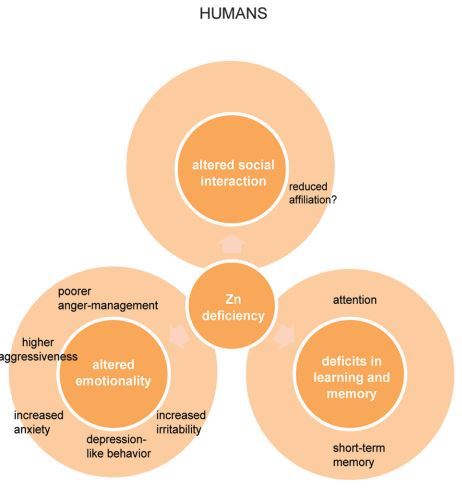
Frequent Zinc shortens colds by 30% - meta-analysis 2017* Zinc lozenges and the common cold: a meta-analysis comparing zinc acetate and zinc gluconate, and the role of zinc dosage {FONT(size="16")} 📄 Download the PDF from Vitamin D Life *{FONT}
Vitamin D Life - studies in both categories Zinc and Vitamin D Receptor
This list is automatically updated
{category}
Zinc and its role in Vitamin D function - April 2022
Current Research in Physiology, Volume 5, 2022, Pages 203-207 https://doi.org/10.1016/j.crphys.2022.04.001
Ashton Amos, Mohammed S. Razzaque
Zinc is an essential mineral with an important relationship with vitamin D. Studies have found that reduced blood zinc levels could predict vitamin D deficiency in adolescent girls, while zinc supplementation increased vitamin D levels in postmenopausal women. In vitro studies using human peritoneal macrophages have found that zinc induced the release of calcitriol (1,25-dihydroxycholecalciferol). Zinc also acts as a cofactor for vitamin D functions, as the transcriptional activity of vitamin D-dependent genes relies on zinc to exert pleiotropic functions, including mineral ion regulation. Vitamin D could also induce zinc transporters to regulate zinc homeostasis. Together, zinc and vitamin D in adequate concentrations help maintain a healthy musculoskeletal system and beyond; however, deficiency in either of these nutrients can result in various disorders affecting almost all body systems. This brief article will focus on the role of zinc in vitamin D functions.
{FONT(size="18")}* 📄 Download the PDF from Vitamin D Life *{FONT}
Zinc: World Health Organization - 2018* WHO as of 2018 ** "Using food availability data, it is estimated that zinc deficiency affects about one-third of the world's population, with estimates ranging from 4% to 73% across subregions"
"Worldwide, zinc deficiency is responsible for approximately 16% of lower respiratory tract infections, 18% of malaria and 10% of diarrhoeal disease"
"Attributable DALYs were higher, with zinc deficiency accounting for about 2.9% of worldwide loss of healthy life years"
Dr. Jockers - 2018* Good Zinc Overview - Dr. Jockers 2018  How To Test for Zinc There are several ways to test zinc levels. One that I am a fan of due to its simplicity and cost-effectiveness is the zinc sulfate taste test. All you do is purchase a bottle of zinc sulfate liquid (this a good one), place a capful in your mouth, and observe the sensations in your mouth. Below are the possible outcomes and indications: ** You Notice No Metallic Taste: Zinc Deficiency
How To Test for Zinc There are several ways to test zinc levels. One that I am a fan of due to its simplicity and cost-effectiveness is the zinc sulfate taste test. All you do is purchase a bottle of zinc sulfate liquid (this a good one), place a capful in your mouth, and observe the sensations in your mouth. Below are the possible outcomes and indications: ** You Notice No Metallic Taste: Zinc Deficiency
You Notice A Delayed Metallic Taste: Slight Zinc Deficiency
You Notice Slight Metallic Taste: Zinc Levels Are Adequate, But Could Be Higher
You Notice Very Strong Metallic Taste: You Likely Have Optimal Zinc Levels* Do You Have A Copper and Zinc Imbalance? Dr. Jockers *Nice article has the following charts and many references
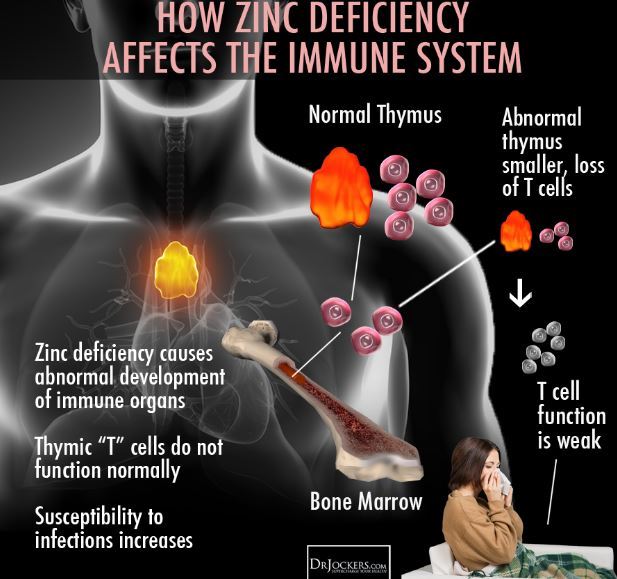
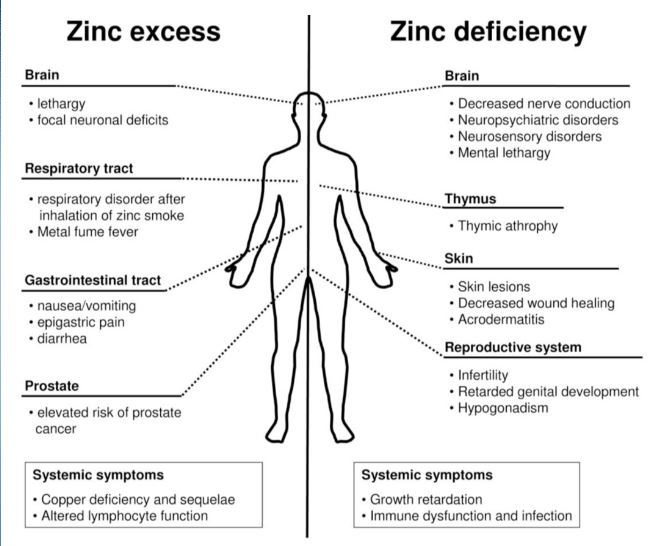
Cochraine Review - Zinc treats colds* 2013 with free PDF *Zinc administered within 24 hours of onset of symptoms reduces the duration of common cold symptoms in healthy people but some caution is needed due to the heterogeneity of the data. As the zinc lozenges formulation has been widely studied and there is a significant reduction in the duration of cold at a dose of ≥ 75 mg/day, for those considering using zinc it would be best to use it at this dose throughout the cold. Regarding prophylactic zinc supplementation, currently no firm recommendation can be made because of insufficient data. When using zinc lozenges (not as syrup or tablets) the likely benefit has to be balanced against side effects, notably a bad taste and nausea.
Low Zinc was the best predictor of Vitamin D <20 ng in Iranian teenage girls - 2019
Diabetes Metab Syndr , 13 (3), 1773-1777 May-Jun 2019, DOI: 10.1016/j.dsx.2019.03.020
An Assessment of the Risk Factors for Vitamin D Deficiency Using a Decision Tree Model
Kayhan Gonoodi 1, Maryam Tayefi 2, Maryam Saberi-Karimian 3, Alireza Amirabadi Zadeh 4, Susan Darroudi 3, Seyed Kazem Farahmand 5, Zahra Abasalti 6, Alireza Moslem 7, Mohsen Nematy 1, Gordon A Ferns 8, Saeid Eslami 9, Majid Ghayour Mobarhan 10
Background and objectives: Vitamin D (25-hydroxyvitamin D or 25OHD) has a key role in the pathogenesis of several chronic disorders. Vitamin D deficiency is a common global public health problem. We aimed to evaluate the risk factors associated with vitamin D deficiency using a decision tree algorithm.
Methods: A total of 988 adolescent girls, aged 12-18 years old, were recruited to the study. Demographic characteristics, serum biochemical factors, all blood count parameters and trace elements such as Zinc, Copper, Calcium and SOD were measured. Serum levels of vitamin D below 20 ng/ml were considered to be deficiency. 70% of these girls (618 cases) were randomly allocated to a training dataset for the constructing of the decision-tree. The remaining 30% (285 cases) were used as the testing dataset to evaluate the performance of decision-tree.
In this model, 14 input variables were included: age, academic attainment of their father, waist circumference, waist to hip ratio,* zinc *, copper, calcium, SOD, FBG, HDL-C, RBC, MCV, MCHC, HCT. The validation of the model was assessed by constructing a receiver operating characteristic (ROC) curve.
Results: The results showed that serum Zn concentration was the most important associated risk factor for vitamin D deficiency. The sensitivity, specificity, accuracy and the area under the ROC curve (AUC) values were 79.3%, 64%, 77.8% and 0.72 respectively using the testing dataset.
Conclusions: The results suggest that the serum levels of Zn is an important associated risk factor for identifying subjects with vitamin D deficiency among Iranian adolescent girls.
Modern-Day Zinc Deficiency Epidemic: Sardi - 2013* Sardi extensive, with many references *---
Vitamin D Life - Zinc and Virus ( studies)
{category}
Grassroots Health on Zinc (with 8-minute video) - Nov 2021* Signs, Symptoms, and Causes of Zinc Deficiency *---
GreenMedInfo: May 2021, Feb 2023* Why Your Body Needs Zinc -- and Top Zinc-Rich Foods May 2021 ** 10 Reasons Why You Need to Eat Enough Zinc Feb 2023 *---
226,000 publications on ZINC and Vitamin D as of Nov 2024* Google Scholar ** Micronutrients in autoimmune diseases: possible therapeutic benefits of zinc and vitamin D - March 202 https://doi.org/10.1016/j.jnutbio.2019.108240 FREE PDF
Serum vitamin D, calcium, and zinc levels in patients with COVID-19 - June 2021 https://doi.org/10.1016/j.clnesp.2021.03.040 FREE PDF
Zinc Increases the Activity of Vitamin D-Dependent Promoters in Osteoblasts - April 2020
https://doi.org/10.1006/bbrc.2000.2570
Zinc and its role in vitamin D function - 2022
Current Research in Physiology Vol 5, 2022, Pages 203-207 https://doi.org/10.1016/j.crphys.2022.04.001
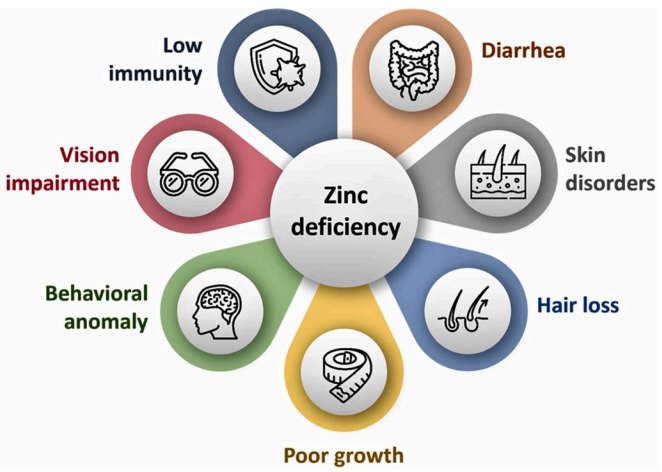
Zinc is an essential mineral with an important relationship with vitamin D. Studies have found that reduced blood zinc levels could predict vitamin D deficiency in adolescent girls, while zinc supplementation increased vitamin D levels in postmenopausal women. In vitro studies using human peritoneal macrophages have found that* zinc induced the release of calcitriol *(1,25-dihydroxycholecalciferol). Zinc also acts as a cofactor for vitamin D functions, as the transcriptional activity of vitamin D-dependent genes relies on zinc to exert pleiotropic functions, including mineral ion regulation. Vitamin D could also induce zinc transporters to regulate zinc homeostasis.
Together, zinc and vitamin D in adequate concentrations help maintain a healthy musculoskeletal system and beyond; however, deficiency in either of these nutrients can result in various disorders affecting almost all body systems. This brief article will focus on the role of zinc in vitamin D functions.
{FONT(size="16")}* 📄 Download the PDF from Vitamin D Life *{FONT}
Zinc is associated with categories: Virus 33, Omega-3 24, Magnesium 23, Vitamin C 20, Iron 16, Resveratrol 9, Pregnancy 8, Vitamin K 8, Vitamin B12 8, Vitamin A 8, Boron 7, Iodine 7, Supplement 6, Breathing 6, Immunity 6, Infant-Child 5, Calcium 5, Curcumin 4, Probiotics 4** as of March 2024__
Close Associations
